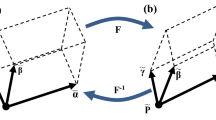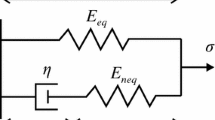Abstract
The constitutive relationships for an anisotropic material are established for shock wave propagation and nonlinear, large deformation computer programs, commonly referred to as hydrocodes. Stresses are formulated in terms of strains; the procedure for separating material compressibility effects (equation of state) from strength effects is formulated which permits the consistent calculation of stresses in the elastic regime, and allows the mean pressure to be defined in accordance with their scalar interpretations. Futher, this procedure permits the computation of inelastic response by scaling of deviatoric stresses, so the equivalent stress resides on a yield or failure surface, without changing the pressure. The procedure for computing the equivalent plastic strain and non-radial return to the yield surface, which results from a calculated overstress, is developed. Also, the transformation matrices for large deformation (rotation), necessary for transformation between material and geometric coordinates, are presented.
Similar content being viewed by others
References
Anderson, C. E.Jr. 1987: An overview of the theory of hydrocodes. Int. J. Impact Engng. 5(1–4): 33–60
Anderson, C. E.Jr.; O'Donoghue, P. E.; Skerhut, D. (1990): A mixture theory approach for the shock response of composite materials. J. Composite Materials 24(11): 1159–1178
Boresi, A. P.; Sidebottom, O. M.; Seely, F. B.; Smith, J. O. 1978: Advanced mechanics of materials, 3rd Edition, John Wiley and Sons
Dienes, J. K. 1979: On rotation and stress rate in deforming bodies. Acta Mechanica 32: 217–232
Flanagan, D. P.; Taylor, L. M. 1987: An accurate numerical algorithm for stress integration with finite rotations. Comp. Meth. in Appl. Mech. and Engng. 62: 305–320
Hill, R. 1948: A theory of yielding and plastic flow of anisotropic metals. Proc. Roy. Soc. Lond., Series A., 193: 281–297
Hughes, T. J. R.; Winget, J. 1980: Finite rotation effects in numerical integration of rate constitutive equations arising in large-deformation analysis. Int. J. Numer. Meths. Engng. 15(12): 1862–1867
Johnson, G. R. 1981: Recent developments and analyses associated with the EPIC-2 and EPIC-3 codes. In: Wang, S. S.; Renton, W. J. (eds.): Advances in Aerospace Structures and Materials, ASME, 1981 AD-01, 141–147
Johnson, G. R.; Colby, D. D.; Vavrick, D. J. 1979: Three-dimensional computer code for dynamic response of solids to intense impulsive loads. Int. J. Num. Meth. In Engng. 14: 1865–1871
Johnson, G. R.; Stryk, R. A. 1992: User instructions for the 1992 Version of the EPIC research code. Alliant Techsystems, Inc., Brooklyn Park, MN, December
Jones, R. M. 1975: Mechanics of composite materials. Hemisphere Publishing Corporation, NY
Malvern, L. E. 1969: Introduction to the mechanics of a continuous media. Prentice-Hall, Inc., Englewood Cliffs, NJ
O'Donoghue, P. E.; Anderson, C. E.Jr.; Friesenhahn, G. J.; Parr, C. H. 1992: A constitutive formulation for anisotropic materials suitable for wave propagation computer programs. J. Composite Materials 26(13): 1860–1884
Tsai, S. W.; Hahn, H. T. 1980: Introduction to composite materials. Technomic Publishing Co., Lancaster, PA
Tuma, J. J. 1979: Engineering mathematics handbook. 2nd Edition, McGraw-Hill Book, Co.
Wilkins, M. L. 1964: Calculations of elastic-plastic flow. In: Adler, B.; Fernback, S.; Rosenberg, M. (eds.): Methods of Computational Physics, vol. 3, Academic Press, NY
Wilkins, M. L. 1969: Calculation of elastic plastic flow. UCRL-7322, Rev. 1, Lawrence Livermore National Laboratory, Livermore, CA
Author information
Authors and Affiliations
Additional information
Communicated by S. N. Atluri, 10 June 1994
Rights and permissions
About this article
Cite this article
Anderson, C.E., Cox, P.A., Johnson, G.R. et al. A constitutive formulation for anisotropic materials suitable for wave propagation computer programs—II. Computational Mechanics 15, 201–223 (1994). https://doi.org/10.1007/BF00375030
Issue Date:
DOI: https://doi.org/10.1007/BF00375030




